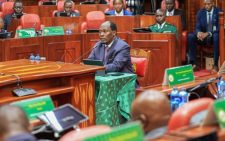Met urges farmers to adopt new seeds to survive low rains

Mwangi Mumero
For Maina Muiyuro, a smallholder farmer at Munyutha village in Kahuro sub-county, Murang’a county, the second planting season this year is nigh.
Already, he has prepared his parcel of land that is punctuated by scattered grevillea trees, a common form of agroforestry.
“We have prepared land, made furrows and added manure on it. We await the rains, which have become unpredictable each passing year,” observes Muiyuro whose farm slopes towards the Kayahwe river.
Farmers in Murang’a county and other parts of the country are waiting for the second planting season, which culminates with the arrival of the short rains cycle running from October, November and December.
However, this time, optimism has been low with reports from the Kenya Meteorological Department predicting depressed rainfall.
Agricultural experts are now calling farmers across Kenya to adapt newer strategies to deal with reduced rainfall.
According to the department outlook released recently, La Nina conditions brought about by near-to-below average Equatorial sea surface temperatures across central to eastern Pacific Ocean is to blame.
Consequently, the department warns that rainfall in time and space is expected to be generally poor in several areas, especially during the months of October and the peak month of November.
As predicted Western counties of Busia, Vihiga, Kakamega, Bungoma as well as those of Nyanza and Rift Valley have started receiving rainfall in the month of September, although the weatherman notes that there is a likelihood to receive near average with a tendency to below-average rainfall.
Short rains are forecast to begin between the third and fourth week of October in Central Kenya and Nairobi.
South Rift Valley, North Eastern and Southern Kenya and parts of the Coast Region will start receiving rains from the end of October up to the end of December.
Farmers in Nyandarua, Kirinyaga, Nyeri, Muranga, Kiambu, Meru, Embu as well as Machakos, Kitui and Makueni counties will have to grapple with depressed rainfall over the period.
The same fate will befall those from Mombasa, Kilifi, Kajiado, parts of Narok, Samburu and Laikipia counties.
“It has been a tough four months in this region with decreased pasture for our cows.
It is bad to hear the Met predictions of reduced rainfall in the coming months,” said Lemaiya Sentamo, a Maasai livestock herder as he moved with his animals near Kitengela town, as dry conditions persist.
Rainfall is critical to pastoralists as well as crop farmers since it leads to availability of grass and other fodder for livestock.
Gloomy outlook for farmers in the month as sunny and dry conditions will prevail in many places as rainfall ends.
“Drier than usual conditions, late onset and long dry spell might lead to agricultural drought, presenting poor prospects for the season.
In the pastoral communities, scarcity of grazing resources until May next year might occur,” the forecast read.
John Waihenya, Murangá County Project Coordinator in the Department of Agriculture says farmers need to change the crops varieties to grow this season as well as adapting other water conservation strategies.
“We are advising farmers to grow pulses, such as beans and pigeon peas. Specifically, KAT Bean 1, 9 and 56.
These have been developed by the Kenya Agricultural and Livestock Research Organisation (Karlo) for semi-arid conditions,” says Waihenya.
Waihenya advises that farmers should plant maize varieties that take two-and-a- half months to three months to mature to help capitalise on the anticipated low rainfall.Hardy cereal crops, such as sorghum are also recommended for drier parts of the country.
He adds that farmers should practise soil and water conservation to reduce loss of water. Conservation agriculture, use of cover crops, mulching and zero tillage are recommended.
The central and county governments have a role in helping cushioning farmers from the perils of depressed rainfall.
According to Waihenya, Murang’a county is giving free maize seeds and fertilisers. Recent media reports also show similar efforts in Kiambu county.
“The national government has also been offering free pesticides to control the fall armyworm to farmers across the country.
Counties also have their own initiatives in pest control measures,” noted Waihenya, who is also the Murang’a county coordinator of the National Agricultural and Rural Inclusive Growth Project (NARIGP).
Technology will also help farmers across Kenya access information on rainfall patterns within their regions with the launch of the Kenya Agricultural Observation Platform (KAOP), a mobile phone application.
Launched by Karlo, mid this year with the support of the World Bank, the app will provide data on probable rainfall amounts in a specific regions, and data on previous rainy days, months and even years.
It will also predict long term and current rainfall location-specific patterns as well as give pest and disease forecasts.
“The app will enable farmers to know the right time to plant t based on the amount of upcoming rainfall.
It will also help farmers mitigate the effect of climate change,” said Peter Munya, Agriculture Cabinet Secretary, during its launch in Karlo, Naivasha.











